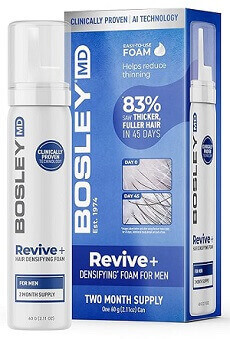I covered Yuva Biosciences (US) very briefly in 2018 in my post on mice and hair growth research. The company founder Dr. Keshav Singh’s team from the University of Alabama managed to reverse skin wrinkles and regrow hair in mice.
They did this via reversing mitochondrial dysfunction. Also see my other 2018 post about mitochondria and hair and my 2017 post on mitochondrial metabolism and hair growth. Dr. Singh is active on Twitter (X) via @mitoscientist. Also check out @YuvaBio.
Yuva Biosciences Releases Hair Loss Product with BosleyMD
On February 20 2024, it was announced that Yuva Biosciences successfully raised $7.5 million in seed funding (led by VentureSouth). More importantly, it recently released its mitochondrial upregulation related hair loss product in partnership with BosleyMD. The separate (but related) Bosley is the most renowned name in the world of hair transplant chains. A newer summary of this development was posted by reader “Fynn” yesterday.
Bosley CEO Dr. Ken Washenik declared that:
“We believe this is one of the biggest innovations in hair loss we’ve seen in twenty-five years.”
Revive+ Densifying Foam

The new topical product is called “Revive Plus Densifying Foam” and it incorporates Yuva Bio’s Y100 trademarked technology (YuvaBio® Y100™). It contains the Amla plant and up-regulates key genes that restore mitochondrial function. In the process hair loss is reduced and hair regrowth is possible.
It is now available for sale on Amazon (image on right) at a price of $44 for a 2-month supply. The current 20 reviews with an average rating of 3.9 out of 5 stars praise the product’s ease of application, non-irritation and non-greasiness. Also see the announcement on Linkedin.
Yuva Biosciences developed this topical foam based hair loss product as follows:
“Using AI, the company combed through thousands of molecules to identify those with the greatest potential to boost mitochondria levels in skin and hair cells, leading to the discovery of its lead compound, Y100.”
Among the ingredients in this product include terminalia chebula extract, biotin, asparagus racemosus root powder, and leuconostoc/radish root ferment.
Also of significance, the Y100 mitochondrial function restoration lead compound molecule is just the first to market. Yuva will continue to use AI to develop other molecules that target mitochondrial dysfunction in order to combat hair loss.
Interestingly, Yuva is also partnering with Elevai Labs, one of the leading suppliers of exosomes to the hair growth market.
Note that BosleyMD also sells a popular Follicle Energizer product that contains hair friendly natural ingredients such as caffeine, biotin and soy.
Dr. Keshav Singh
Dr. Keshav Singh is the Chief Scientific Officer and Co-Founder of Yuva Biosciences. He is a Harvard-trained researcher, the founding Editor-in-Chief of the journal Mitochondrion, and the author of over 100 scientific studies on mitochondria.
For a long time it has been known that mitochondrial dysfunction is a key factor in aging. However, Dr. Singh was the first to discover and prove experimentally that mitochondrial dysfunction is a key cause of hair and skin aging. I discussed his groundbreaking 2018 study in my earlier mentioned post on mice hair growth research.
Company co-founder and CEO Greg Schmergel is an accomplished entrepreneur. Also working with them is Dr. Shekhar Mitra, a past Senior Vice President of Corporate Innovation at Procter & Gamble.